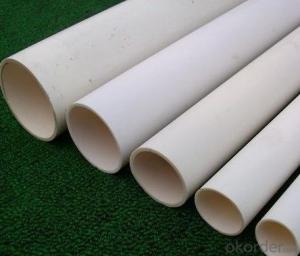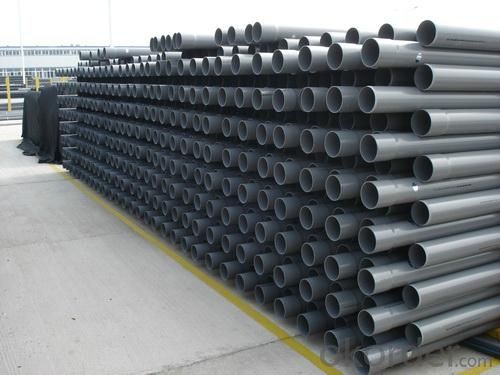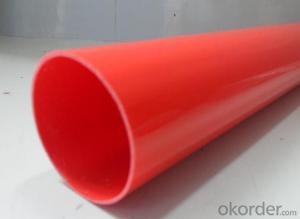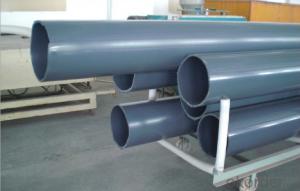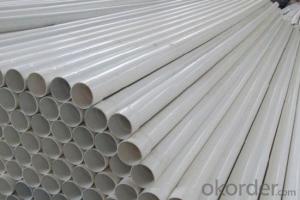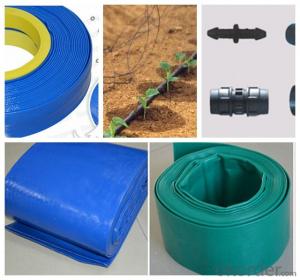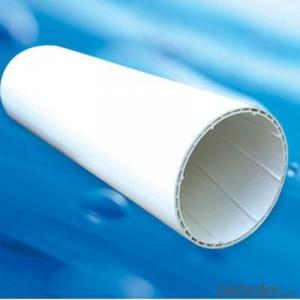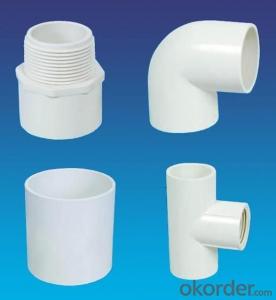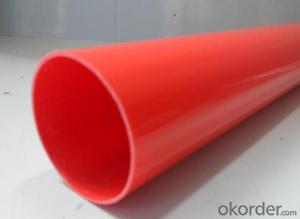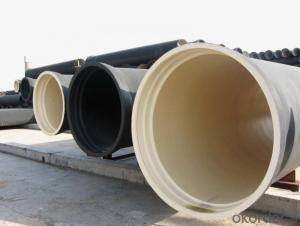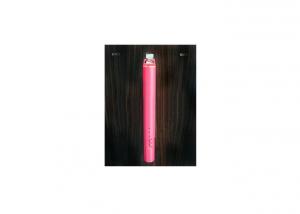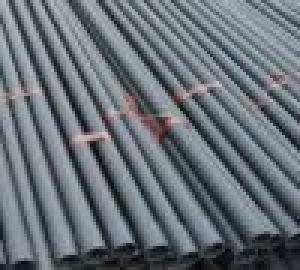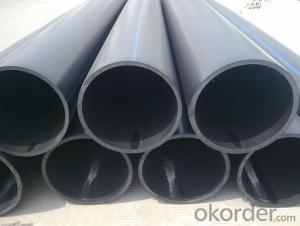PVC Pipe Length:5.8/11.8m Plastic Tubes - Standard:GB
- Loading Port:
- China main port
- Payment Terms:
- TT OR LC
- Min Order Qty:
- 999 pc
- Supply Capability:
- 9999 pc/month
OKorder Service Pledge
OKorder Financial Service
You Might Also Like
1.Description of PVC Pipe :
Material: Virgin Rigid PVC resin, no recycle material
Process: vacuum forming extrusion
Color: various colors, we can make color according to Panton card No.
Back working procedure: precise length cutting, drilling/slotting/punching, gold stamping, quality inspection, cleaning, assembling, and packing.
Application:construction, home decoration, stationery&toy, advertising, ornament, etc.
Common Feature: high glossy, water proof, damp proof, termite proof, shock proof, fire retardant, Maintenance free, light weight ,easy to install, economical, durability, recyclable
2.Features of pvc pipes :
1) Small resistance to fluidity: The smooth surface reduces resistance to the fluids. Its roughness coefficient is only 0.009, much less than other pipes, Under same discharges, smaller cabibre of the pipe can be uesd.
2) Strong mechanical strength: Good resistance to water pressure, outside impact and pressure, is satisfied under any conditions.
3) Good electrical insulation: excellent insulation nature against electricity. the pvc pipe can be served as conduits and pipes in construction cable and wire.
4) Water quality unaffected: The solution tests on the PVC pipe show no affect on water quality when the water flows through is. It is considered the best piping material for running water works.
5) Simple installation: Very easy to connect, thus much time and laborcost may be saved.
3.PVC Pipe Images:
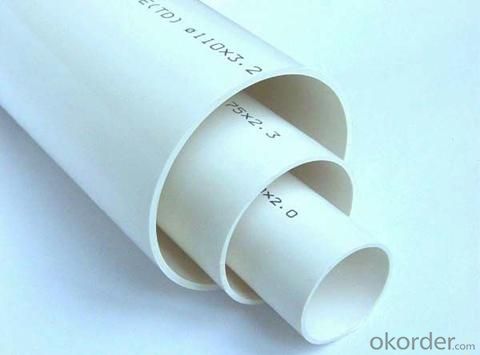
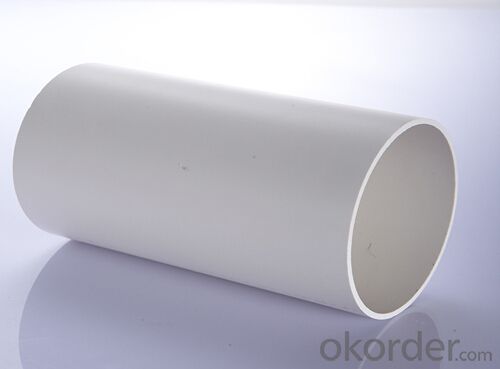
4.Specifications of the pvc pipe:
1) Material: pvc pipe unplasticized polyvinyl chloride
2) Standard: GB, ISO9001, ISO14001
3) Color: white pvc pipe, grey pvc pipe , etc.
4) Specific Gravity:g/cm3, 20(C): 1.35 - 1.55
5) Vicat Softening Temperature: (C) >=79
6) Longitudinal Reversion: %, 150(C) <=5< span=""><>
7) Dichloromethane Resistance Test: No attack
8) Falling Weight Impact Test: TIR, %, 0(C) <=10< span=""><>
9) Tensile Yield Strength: Mpa >=40
10) Fitness of Water Tightness Test: No Leakage
11) Fitness of Air Tightness Test: No Leakage
5.FAQ
Q:What is you MOQ?
A:As customer’s request.
Q:What is the production ability? or delivery time?
A:Our production ability support 40HQ order finish in one week.
Q:What is the regular shipping port?
A:Tianjin or Shanghai.
Q:What is your payment?
A:TT or CC.
Q:Can we have sample?
A:Sample free, freight cost you.
Q:For urgently doubts,who online?
A:Sales and marketing Manager 24hours online service.
- Q: The point is to remove as many sticks as you can without the marbles falling through.Anyone know? Thanks :)
- KerPlunk
- Q: How are plastic tubes filled with products?
- Plastic tubes are typically filled with products through a process called tube filling. This involves using specialized machinery that dispenses the product into the tube through a nozzle or pump. The tube is then sealed, usually using a heat sealing method, to ensure product integrity.
- Q: I have a long flexible 1 plastic tube that is attached to itself forming a closed circuit and I'd like to add an electric blower to it to flow air continuously that will make a small ball go around continuously. I'd like to splice the blower into the 1 plastic tube but need to know where or how to exhaust the air to keep the air circuit moving continuously in one direction.
- You can't place the blower in-line, as that will block the ball unless you have a specially built blower so that it can allow the ball to pass through the blower You need an arrangement that is something like a jet pump used for pumping water. The blower needs to be big enough (needs to move sufficient air volume) such that the amount of air in the tube is a relatively small fraction of the total air being moved by the blower. The blower needs to be connected to the main loop via a wye. A second wye, oriented in the opposite direction allows air to exhaust from the loop. A trap (parallel bars in the wye) is necessary to keep the ball from exiting the wye. The cross-sectional area of the loop between the wyes needs to be large enough so that you don't produce back pressure on the loop due to the blower's pressure. It is going to take some fussing around with the diameter of the loop between the two wyes and with the outlet diameter of the exhaust to get it right. Think of a loop with a line tangent to the loop and connected to the loop. Your blower is at one end of the line and the exhaust is at the other end. All you are doing is blowing air past the air that resides in the line, dragging those air molecules along with the velocity of the air being injected by the blower. A small fraction of the air will circulate around the loop and will carry the ball with it.
- Q: Are plastic tubes safe for storing cosmetics?
- Yes, plastic tubes are generally safe for storing cosmetics. However, it is important to ensure that the plastic used is of high quality and is free from harmful chemicals like BPA. Additionally, it is advisable to choose tubes made from non-reactive plastics to prevent any potential interactions between the cosmetic product and the packaging.
- Q: Are plastic tubes suitable for pneumatic conveying systems?
- Yes, plastic tubes are suitable for pneumatic conveying systems. They offer several advantages such as being lightweight, corrosion-resistant, and easy to install. Plastic tubes also have good flexibility, allowing them to navigate bends and curves more easily. Additionally, they are cost-effective and can handle a wide range of materials, making them a popular choice for pneumatic conveying applications.
- Q: What is the level of transparency of plastic tubes?
- The level of transparency of plastic tubes can vary depending on the type and quality of the plastic used. Some plastic tubes may have high transparency, allowing for clear visibility of the contents inside, while others may have a lower level of transparency, resulting in a more opaque appearance.
- Q: Can plastic tubes be used for cable protection?
- Yes, plastic tubes can be used for cable protection. They provide a protective covering for cables, helping to prevent damage from external factors such as moisture, dust, and physical stress. Plastic tubes are commonly used in various industries and applications to ensure the longevity and reliability of cables.
- Q: Are plastic tubes resistant to abrasion?
- Yes, plastic tubes are generally resistant to abrasion.
- Q: Can plastic tubes be used for industrial applications?
- Yes, plastic tubes can be used for industrial applications. They are commonly used for tasks such as fluid transportation, chemical processing, and conveying materials in industries such as manufacturing, food processing, and pharmaceuticals. Plastic tubes offer advantages like corrosion resistance, flexibility, and easy installation, making them suitable for various industrial needs.
- Q: I own a 1995 Toyota Celica. A plastic tube next to the aluminum tube eventually rubbed a hole. Can this aluminum tube be repaired, or do I have to replace the entire thing?
- I doubt it. If it's an AC line it has to be replaced. Aluminum is difficult to weld,
Send your message to us
PVC Pipe Length:5.8/11.8m Plastic Tubes - Standard:GB
- Loading Port:
- China main port
- Payment Terms:
- TT OR LC
- Min Order Qty:
- 999 pc
- Supply Capability:
- 9999 pc/month
OKorder Service Pledge
OKorder Financial Service
Similar products
Hot products
Hot Searches
Related keywords
